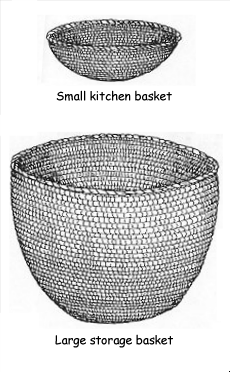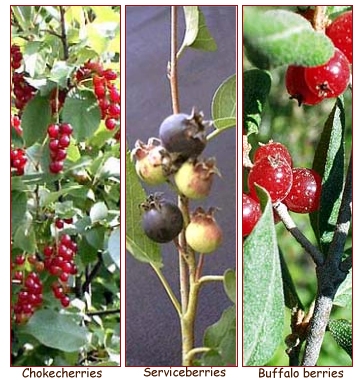Traditional Foods and Recipes
Camas
In addition to the staple food pemmican, camas roots and "biscuit root" were other reliable and favorite food sources
Both are small flowering plants that grow in the mountains and hills; when the plants were mature, the Indians would dig up the roots and collect them. The roots can be cooked fresh (sort of like a potato dumpling in your stew) or they can be dried and peeled and ground into flour.
 A grinding stone was used for this. Some grinding stones were small enough to travel with the people when they moved. They were flat, with a kind of hollowed-out section in the middle. A smaller smooth rounded stone was held in the hands and rolled or pounded over dried roots and other materials to pulverize them on the grinding stone.
A grinding stone was used for this. Some grinding stones were small enough to travel with the people when they moved. They were flat, with a kind of hollowed-out section in the middle. A smaller smooth rounded stone was held in the hands and rolled or pounded over dried roots and other materials to pulverize them on the grinding stone.
In the Southwest, the Spanish word for grinding stone is metate, pronounced "Meh-TAH-tay."
Some grinding stones were giant-sized rocks with a hollow smooth concave part on the top. They were way too big to move them, but were located in certain spots the Indians knew about and could be used while traveling.
Camas is a beautiful small lily-like flower that grows in damp places across the Pacific Northwest.
There are white camas and blue camas; the white ones are called "death camas" and are very poisonous. The blue ones are edible.
The blue blossoms must be observed at the time they bloom to avoid selecting the deadly white or green-flowering camas.
The bulbs are ripe for eating after the flowers are gone, and once they're gone, it is nearly impossible to tell the plants apart. Some of the very wise old women in the tribe were known for being able to tell the plants apart after they'd bloomed.
The camas bulbs were harvested at the seed pod stage. They were peeled and eaten fresh, or dried in the sun for year-round use.
Often they were "barbecued" by cooking them buried in a pit for about a day. Certain kinds of firewood and seasonings might be used to flavor the camas. For example, the bulbs could be placed on hot flat stones in a pit and then covered with skunk cabbage leaves followed by fresh pine needles. A fire was built on top, and it was kept going for a couple of days. The camas bulbs were blackened, and they could be eaten like that or baked with salmon.
Camas is high in Vitamin C and is a very good source of iron.
Biscuit Root
 The biscuit root is a pretty little wildflower that grows on dry, rocky hillsides and flats across Nez Perce country. The root is dug up after the seeds are formed, so it's easier to peel.
The biscuit root is a pretty little wildflower that grows on dry, rocky hillsides and flats across Nez Perce country. The root is dug up after the seeds are formed, so it's easier to peel.
It could be cooked fresh as a vegetable, or dried whole, and was often ground into flour after being peeled and dried in the sun. The flour was used to make breads and biscuits. Indians would form the dough into a little biscuit shape and drop it into the hot ashes at the edge of a campfire, where it would cook into an "ash cake." You just blow off the ashes and eat it! The dough can also be wrapped around the end of a green stick and toasted in the fire (kind of like toasting marshmallows). Toasted biscuit root dough with wild currant jam is a real treat!
If the biscuit root is dried and chopped up, little pieces of it can also be stirred into soups or stews to thicken them like potatoes.
The dried whole roots were also eaten as snacks. Like camas, the biscuit root is high in Vitamin C and iron.
Steamed Clover
The Shoshone Indians lived in an area where the weather was harsh and food was not as plentiful as in other areas. One of the foods they depended on was greens like clover. They steamed it by laying wet clover between rows or stacks of hot stones. It was tasty and nutritious. Some clovers, such as tall red clover, are very sweet and honey-flavored; others have a citrus-like flavor.
You can try gathering some if you know a place where clover grows and it hasn't been treated with pesticides or herbicides. Better yet, if you don't have clover, you can buy fresh spinach or other greens at the store and steam that. Beet tops, collards, mustard greens, or turnip greens are also good.
Wash the leaves well and put a handful in a small pot on the stove. Add ¼ cup of water. Cover with a lid and simmer for 2-3 minutes.
For really tasty greens, add a teaspoon of vinegar, a chopped fresh tomato, a tablespoon of honey, and a dash of oregano. A piece of cooked crumbled bacon is also really good.
The Diggers were a Shoshone group who lived in a very dry, harsh land where food was hard to find. Few animals even lived there. Sometimes the people would herd a lot of grasshoppers into a pit and kill them with branches. They would gather up the hoppers, mash them to a paste, form that into cakes, and let them dry in the sun. Have you ever been hungry enough to eat grasshopper cakes? (Note: It's not like that recipe for grasshopper pie.)
Fry Bread
- 2 cups flour
- 2 teaspoons baking powder
- ½ teaspoon salt
- 1 tablespoon sunflower oil
- ¾ cup water

Wash your hands well before you start. Mix the dry ingredients in a large mixing bowl, then add the oil and water and mix it in with a large spoon. Dust your hands with flour to keep them from getting sticky, and mix the dough with your hands till it's stretchy, but not sticky. Don't use a lot of flour or the dough will get heavy. When it's smooth, pull off a clump of the dough about the size of a plum and roll it into a ball with your hands.
Squeeze the dough ball gently between your hands until it's flat. Then gently pull the dough to stretch it out until it's thin. This takes a bit of practice.
If you can't get yours stretched thin, lay it on a surface dusted with flour and roll it flat with a rolling pin.
Punch a hole through the center with your thumb. This hole will help the bread cook evenly.
Ask an adult to help you fry the bread in a few inches of hot oil, preferably canola oil or peanut oil. When one side turns a light brown color, turn it over with two forks or a long metal spatula, and cook the other side.
Be very careful around hot oil! An adult must help.
Put the hot bread on a plate covered with a paper towel to drain and cool.
Sprinkle the bread with powdered sugar and drizzle it with honey for a sweet treat. To make a meal, spoon hot chili, beans, or stew onto the bread.
This recipe makes 8 to 10 pieces. Another way to make the bread is to use homemade bread dough or store-bought frozen bread dough.
Fry bread is a very popular Indian food today. It is made and sold throughout the country. It's a traditional food of the Navajo people, but many other tribes enjoy it too. Some of the grandmothers are famous for the way they make the most delicious fry bread.

The Nez Perce often used a large buffalo horn or a hand-carved wooden ladle to fill bowls that were made of clay, wood, shell, or tightly woven baskets. People used spoons made from wood or horn.
Many of the Southwestern tribes made beautiful pottery containers -- jugs and jars and bottles and bowls. Some of the Northern tribes did, too. They were especially well-known for their beautiful woven baskets, which were constructed from all sorts of plant materials, including grasses, reeds, twigs, cords made from dogwood, and even pine needles. Baskets of every size and shape could be made from these materials -- and still are today. Some were plain and others were beautifully decorated.
Fruit Leather
 The Nez Perce and other tribes picked and ate many kinds of wild berries such as strawberries, blueberries, wild grapes, huckleberries, serviceberries, currants, cranberries, and many more.
The Nez Perce and other tribes picked and ate many kinds of wild berries such as strawberries, blueberries, wild grapes, huckleberries, serviceberries, currants, cranberries, and many more.
Researchers have found there were 36 different kinds of fruit that Indians dried to eat in the winter. They knew what the plants looked like, where they grew, and when they got ripe every year.
Berries were carried home in baskets and eaten fresh, but they were also dried and saved for winter.
You can make a dried fruit snack using fresh or frozen berries. You will need 2 cups of ripe fruit (berries, cherries, plums, apricots, peaches, apples, or a mixture of these).
Wash the fruit and let it drain on a clean towel. Wash your hands well, then carefully cut the fruit into small chunks. Leave the peels on -- they are chewy and nutritious.
Put the fruit into a blender or food processor and blend on high for 15 seconds. Cover a large flat cookie sheet with plastic wrap or wax paper, then pour the fruit mixture onto it. Let it dry in a warm place for a day or so.
To eat the fruit leather, peel the fruit off the plastic wrap. You can also roll it up in the plastic wrap and keep it in a covered container (like a cookie jar or refrigerator box) if you want to store it.
Drinks
 Thirsty children usually drank icy cold water from mountain streams or rivers. They also had special drinks now and then. For example, honey or maple syrup was mixed with water to make a punch, and leaves were used to flavor other drinks. The dried leaves of snowberry, wintergreen, spruce and twigs of raspberry, chokecherry, and wild cherry were dropped into boiling water to make teas. Many kinds of flowers were dried and used to make teas.
Thirsty children usually drank icy cold water from mountain streams or rivers. They also had special drinks now and then. For example, honey or maple syrup was mixed with water to make a punch, and leaves were used to flavor other drinks. The dried leaves of snowberry, wintergreen, spruce and twigs of raspberry, chokecherry, and wild cherry were dropped into boiling water to make teas. Many kinds of flowers were dried and used to make teas.
Wild mint leaves were used to flavor teas and punch.
You can make a tea like the Indian children enjoyed. You can buy fresh mint leaves at the store, and you'll need some fresh berries or other fruit. Put a couple tablespoons of fruit in a cup, add a mint leaf or two and a spoonful of honey, then pour in hot water till the cup is not quite full. Let it rest a minute or two, then stir very gently and sip your tea!
SWEET NOTE: Maple syrup or honey was also used to sweeten medicines made from bitter plants, so the children would eat or drink them -- just like some medicine today!

